Deck 6: Microbial Growth
Question
Question
Question
Question
Question
Question
Question
Question
Question
Question
Question
Question
Question
Question
Question
Question
Question
Question
Question
Question
Question
Question
Question
Question
Question
Question
Question
Question
Question
Question
Question
Question
Question
Question
Question
Question
Question
Question
Question
Question
Question
Question
Question
Question
Question
Question
Question
Question
Question
Question
Question
Question
Question
Question
Question
Question
Question

Unlock Deck
Sign up to unlock the cards in this deck!
Unlock Deck
Unlock Deck
1/57
Play
Full screen (f)
Deck 6: Microbial Growth
1
Figure 6.1
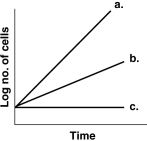
In Figure 6.1, which line best depicts a psychrotroph incubated at 0°C?
A) a
B) b
C) c

In Figure 6.1, which line best depicts a psychrotroph incubated at 0°C?
A) a
B) b
C) c
B
2
The biosafety level (BSL) for most introductory microbiology laboratories is
A) BSL- 1.
B) BSL- 2.
C) BSL- 3.
D) BSL- 4.
A) BSL- 1.
B) BSL- 2.
C) BSL- 3.
D) BSL- 4.
A
3
Which enzyme catalyzes the reaction: O2- + O2- + 2H+ -H2O2 + O2?
A) oxidase
B) peroxidase
C) superoxide dismutase
D) catalase
A) oxidase
B) peroxidase
C) superoxide dismutase
D) catalase
C
4
Table 6.1
Three different culture media are shown below.
-For the three types of media in Table 6.1, which medium (or media) is/are chemically defined?
A) A
B) B
C) C
D) A and B
E) A and C
Three different culture media are shown below.
-For the three types of media in Table 6.1, which medium (or media) is/are chemically defined?
A) A
B) B
C) C
D) A and B
E) A and C

Unlock Deck
Unlock for access to all 57 flashcards in this deck.
Unlock Deck
k this deck
5
Figure 6.1
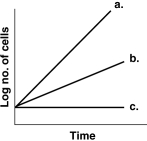
In Figure 6.1, which line best depicts a facultative anaerobe in the absence of O2?
A) a
B) b
C) c

In Figure 6.1, which line best depicts a facultative anaerobe in the absence of O2?
A) a
B) b
C) c

Unlock Deck
Unlock for access to all 57 flashcards in this deck.
Unlock Deck
k this deck
6
Which of the following elements is NOT correctly matched with its cellular function?
A) phosphorus - incorporated into nucleic acids
B) magnesium and potassium - required as cofactors for enzymes
C) nitrogen - needed for amino acid synthesis
D) sulfur - used for synthesis of thiamin and biotin
E) None of the answers is correct; all of the elements are correctly matched.
A) phosphorus - incorporated into nucleic acids
B) magnesium and potassium - required as cofactors for enzymes
C) nitrogen - needed for amino acid synthesis
D) sulfur - used for synthesis of thiamin and biotin
E) None of the answers is correct; all of the elements are correctly matched.

Unlock Deck
Unlock for access to all 57 flashcards in this deck.
Unlock Deck
k this deck
7
Which of the following is an advantage of the direct microscopic count?
A) sample volume is unknown
B) requires a large number of cells
C) requires no incubation time
D) can easily distinguish live from dead cells
E) can readily count organisms that are motile
A) sample volume is unknown
B) requires a large number of cells
C) requires no incubation time
D) can easily distinguish live from dead cells
E) can readily count organisms that are motile

Unlock Deck
Unlock for access to all 57 flashcards in this deck.
Unlock Deck
k this deck
8
Figure 6.1
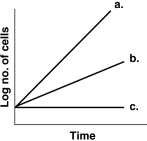
In Figure 6.1, which line best illustrates the growth of a facultative anaerobe incubated aerobically?
A) a
B) b
C) c

In Figure 6.1, which line best illustrates the growth of a facultative anaerobe incubated aerobically?
A) a
B) b
C) c

Unlock Deck
Unlock for access to all 57 flashcards in this deck.
Unlock Deck
k this deck
9
The term aerotolerant anaerobe refers to an organism that
A) requires less oxygen than is present in air.
B) is killed by oxygen.
C) requires more oxygen than is present in air.
D) uses oxygen or grows without oxygen.
E) does not use oxygen but tolerates it.
A) requires less oxygen than is present in air.
B) is killed by oxygen.
C) requires more oxygen than is present in air.
D) uses oxygen or grows without oxygen.
E) does not use oxygen but tolerates it.

Unlock Deck
Unlock for access to all 57 flashcards in this deck.
Unlock Deck
k this deck
10
Figure 6.3

In Figure 6.3, which tube shows the expected growth pattern for a microaerophile?
A) a
B) b
C) c
D) d
E) e

In Figure 6.3, which tube shows the expected growth pattern for a microaerophile?
A) a
B) b
C) c
D) d
E) e

Unlock Deck
Unlock for access to all 57 flashcards in this deck.
Unlock Deck
k this deck
11
Most fungi grow best at pH
A) 1.
B) 5.
C) 7.
D) 9.
E) 14.
A) 1.
B) 5.
C) 7.
D) 9.
E) 14.

Unlock Deck
Unlock for access to all 57 flashcards in this deck.
Unlock Deck
k this deck
12
Figure 6.1
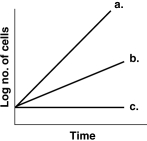
In Figure 6.1 ,which line best depicts an obligate anaerobe in the presence of O2?
A) a
B) b
C) c

In Figure 6.1 ,which line best depicts an obligate anaerobe in the presence of O2?
A) a
B) b
C) c

Unlock Deck
Unlock for access to all 57 flashcards in this deck.
Unlock Deck
k this deck
13
Figure 6.1
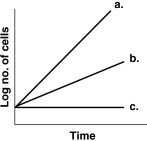
In Figure 6.1, which line shows the growth of an obligate aerobe incubated anaerobically?
A) a
B) b
C) c

In Figure 6.1, which line shows the growth of an obligate aerobe incubated anaerobically?
A) a
B) b
C) c

Unlock Deck
Unlock for access to all 57 flashcards in this deck.
Unlock Deck
k this deck
14
Assume you inoculated 100 cells into 100 ml of nutrient broth. You then inoculated 100 cells of the same species into 200 ml of nutrient broth. After incubation for 24 hours, you should have
A) the same number of cells in both.
B) more cells in the 100 ml.
C) more cells in the 200 ml.
D) The answer cannot be determined based on the information provided.
A) the same number of cells in both.
B) more cells in the 100 ml.
C) more cells in the 200 ml.
D) The answer cannot be determined based on the information provided.

Unlock Deck
Unlock for access to all 57 flashcards in this deck.
Unlock Deck
k this deck
15
Pathogenic bacteria isolated from the respiratory or intestinal tracts of humans are
A) capnophiles that grow best in carbon dioxide incubators.
B) capnophiles that prefer highly oxygenated growth conditions.
C) strict aerobes that grow best in candle jars.
D) facultative anaerobes that require reducing media for growth.
E) strict aerobes that grow best in reducing media.
A) capnophiles that grow best in carbon dioxide incubators.
B) capnophiles that prefer highly oxygenated growth conditions.
C) strict aerobes that grow best in candle jars.
D) facultative anaerobes that require reducing media for growth.
E) strict aerobes that grow best in reducing media.

Unlock Deck
Unlock for access to all 57 flashcards in this deck.
Unlock Deck
k this deck
16
Which group of microorganisms is most likely to spoil a freshwater trout preserved with salt?
A) facultative halophiles
B) anaerobes
C) hyperthermophiles
D) psychrophiles
E) thermophiles
A) facultative halophiles
B) anaerobes
C) hyperthermophiles
D) psychrophiles
E) thermophiles

Unlock Deck
Unlock for access to all 57 flashcards in this deck.
Unlock Deck
k this deck
17
A culture medium on which only gram- positive organisms grow and a yellow halo surrounds Staphylococcus aureus colonies is called a(n)
A) enrichment culture.
B) differential medium.
C) selective medium.
D) selective and differential medium.
E) differential and enrichment culture.
A) enrichment culture.
B) differential medium.
C) selective medium.
D) selective and differential medium.
E) differential and enrichment culture.

Unlock Deck
Unlock for access to all 57 flashcards in this deck.
Unlock Deck
k this deck
18
Which of the following is an example of a metabolic activity that could be used to measure microbial growth?
A) glucose consumption
B) turbidity
C) MPN
D) standard plate count
E) direct microscopic count
A) glucose consumption
B) turbidity
C) MPN
D) standard plate count
E) direct microscopic count

Unlock Deck
Unlock for access to all 57 flashcards in this deck.
Unlock Deck
k this deck
19
The source of nutrients in nutrient agar is
A) agar.
B) nutrient.
C) peptone and beef extract.
D) peptone and NaCl.
E) agar and NaCl.
A) agar.
B) nutrient.
C) peptone and beef extract.
D) peptone and NaCl.
E) agar and NaCl.

Unlock Deck
Unlock for access to all 57 flashcards in this deck.
Unlock Deck
k this deck
20
Figure 6.3

In Figure 6.3, which tube shows the expected growth pattern for a facultative anaerobe?
A) a
B) b
C) c
D) d
E) e

In Figure 6.3, which tube shows the expected growth pattern for a facultative anaerobe?
A) a
B) b
C) c
D) d
E) e

Unlock Deck
Unlock for access to all 57 flashcards in this deck.
Unlock Deck
k this deck
21
Which of the following is an organic growth factor?
A) H2O
B) glucose
C) vitamin B1
D) NH4H2PO4
E) peptone
A) H2O
B) glucose
C) vitamin B1
D) NH4H2PO4
E) peptone

Unlock Deck
Unlock for access to all 57 flashcards in this deck.
Unlock Deck
k this deck
22
Which enzyme catalyzes the reaction: H2O2 + 2H+ -2H2O?
A) superoxide dismutase
B) peroxidase
C) catalase
D) oxidase
A) superoxide dismutase
B) peroxidase
C) catalase
D) oxidase

Unlock Deck
Unlock for access to all 57 flashcards in this deck.
Unlock Deck
k this deck
23
A sample of milk is tested for its bacterial content in a plate count assay. A one- milliliter sample of the milk is diluted in a 1:10 dilution series. One milliliter of the third dilution tube is plated in a pour plate. After incubation, the plate has 54 colonies, indicating that the original milk sample contained
A) 54 cells.
B) 540 cells.
C) 5400 cells.
D) 54,000 cells.
E) 540,000 cells.
A) 54 cells.
B) 540 cells.
C) 5400 cells.
D) 54,000 cells.
E) 540,000 cells.

Unlock Deck
Unlock for access to all 57 flashcards in this deck.
Unlock Deck
k this deck
24
If cells are grown in media containing amino acids labeled with radioactive nitrogen (15N), most of radioactivity will be found in the cells'
A) DNA.
B) proteins.
C) phospholipids.
D) DNA and proteins.
E) DNA and phospholipids.
A) DNA.
B) proteins.
C) phospholipids.
D) DNA and proteins.
E) DNA and phospholipids.

Unlock Deck
Unlock for access to all 57 flashcards in this deck.
Unlock Deck
k this deck
25
Which of the following is NOT a direct method to measure microbial growth?
A) metabolic activity
B) filtration
C) standard plate count
D) most probable number (MPN)
E) direct microscopic count
A) metabolic activity
B) filtration
C) standard plate count
D) most probable number (MPN)
E) direct microscopic count

Unlock Deck
Unlock for access to all 57 flashcards in this deck.
Unlock Deck
k this deck
26
Thirty- six colonies grew in nutrient agar from 1.0 ml of undiluted sample in a standard plate count. How many cells were in the original sample?
A) 4
B) 9
C) 18
D) 36
E) 72
A) 4
B) 9
C) 18
D) 36
E) 72

Unlock Deck
Unlock for access to all 57 flashcards in this deck.
Unlock Deck
k this deck
27
Patients with indwelling catheters are susceptible to infections because
A) infections can be transmitted from other people.
B) bacteria cause infections.
C) biofilms develop on catheters.
D) injected solutions are contaminated.
E) their immune systems are weakened.
A) infections can be transmitted from other people.
B) bacteria cause infections.
C) biofilms develop on catheters.
D) injected solutions are contaminated.
E) their immune systems are weakened.

Unlock Deck
Unlock for access to all 57 flashcards in this deck.
Unlock Deck
k this deck
28
In one hospital, Pseudomonas aeruginosa serotype 10 infected the biliary tract of 10 percent of 1300 patients who underwent gastrointestinal endoscopic procedures. After each use, endoscopes were washed with an automatic reprocessor that flushed detergent and glutaraldehyde through the endoscopes, followed by a tap water rinse. P. aeruginosa 10 was not isolated from the detergent, glutaraldehyde, or tap water. What was the source of the infections?
A) a biofilm in the reprocessor
B) fecal contamination of the bile ducts
C) contaminated disinfectant
D) bacterial cell walls in the water
E) None of the answers is correct.
A) a biofilm in the reprocessor
B) fecal contamination of the bile ducts
C) contaminated disinfectant
D) bacterial cell walls in the water
E) None of the answers is correct.

Unlock Deck
Unlock for access to all 57 flashcards in this deck.
Unlock Deck
k this deck
29
Which of the following is the best definition of generation time?
A) the length of time needed for lag phase
B) the duration of log phase
C) the minimum rate of doubling
D) the time needed for nuclear division
E) the length of time needed for a cell to divide
A) the length of time needed for lag phase
B) the duration of log phase
C) the minimum rate of doubling
D) the time needed for nuclear division
E) the length of time needed for a cell to divide

Unlock Deck
Unlock for access to all 57 flashcards in this deck.
Unlock Deck
k this deck
30
Figure 6.2

Figure 6.2 shows a typical bacterial growth curve with the x- axis indicating the log of the number of bacteria and the y- axis indicating time in culture. In the figure, which section (or sections) shows a growth phase where the number of cells dying equals the number of cells dividing?
A) a
B) b
C) c
D) d
E) a and c

Figure 6.2 shows a typical bacterial growth curve with the x- axis indicating the log of the number of bacteria and the y- axis indicating time in culture. In the figure, which section (or sections) shows a growth phase where the number of cells dying equals the number of cells dividing?
A) a
B) b
C) c
D) d
E) a and c

Unlock Deck
Unlock for access to all 57 flashcards in this deck.
Unlock Deck
k this deck
31
Most bacteria grow best at pH
A) 1.
B) 5.
C) 7.
D) 9.
E) 14.
A) 1.
B) 5.
C) 7.
D) 9.
E) 14.

Unlock Deck
Unlock for access to all 57 flashcards in this deck.
Unlock Deck
k this deck
32
The addition of which of the following to a culture medium will neutralize acids?
A) buffers
B) heat
C) sugars
D) carbon
E) pH
A) buffers
B) heat
C) sugars
D) carbon
E) pH

Unlock Deck
Unlock for access to all 57 flashcards in this deck.
Unlock Deck
k this deck
33
Which of the following is an advantage of the standard plate count?
A) provides immediate results
B) determines the number of viable cells
C) can be used to count heat- sensitive bacteria
D) can be performed on very dilute samples, such as lake water
E) can readily count cells that form aggregates
A) provides immediate results
B) determines the number of viable cells
C) can be used to count heat- sensitive bacteria
D) can be performed on very dilute samples, such as lake water
E) can readily count cells that form aggregates

Unlock Deck
Unlock for access to all 57 flashcards in this deck.
Unlock Deck
k this deck
34
Figure 6.2
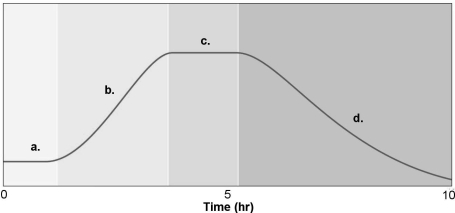
Figure 6.2 shows a typical bacterial growth curve with the x- axis indicating the log of the number of bacteria and the y- axis indicating time in culture. In the figure, which sections of the graph illustrate a logarithmic change in cell numbers?
A) a and c
B) b and d
C) a and b
D) c and d
E) a and d

Figure 6.2 shows a typical bacterial growth curve with the x- axis indicating the log of the number of bacteria and the y- axis indicating time in culture. In the figure, which sections of the graph illustrate a logarithmic change in cell numbers?
A) a and c
B) b and d
C) a and b
D) c and d
E) a and d

Unlock Deck
Unlock for access to all 57 flashcards in this deck.
Unlock Deck
k this deck
35
Which of the following pairs is mismatched?
A) mesophile - growth at 25°C
B) thermophile - growth at 37°C
C) psychrophile - growth at 15°C
D) hyperthermophiles - growth at 85°C
E) psychrotroph - growth at 0°C
A) mesophile - growth at 25°C
B) thermophile - growth at 37°C
C) psychrophile - growth at 15°C
D) hyperthermophiles - growth at 85°C
E) psychrotroph - growth at 0°C

Unlock Deck
Unlock for access to all 57 flashcards in this deck.
Unlock Deck
k this deck
36
During which growth phase will gram- positive bacteria be most susceptible to penicillin?
A) death phase
B) log phase
C) lag phase
D) stationary phase
E) The culture is equally susceptible during all phases.
A) death phase
B) log phase
C) lag phase
D) stationary phase
E) The culture is equally susceptible during all phases.

Unlock Deck
Unlock for access to all 57 flashcards in this deck.
Unlock Deck
k this deck
37
Which enzyme catalyzes the reaction: 2H2O2 -2H2O + O2?
A) superoxide dismutase
B) catalase
C) oxidase
D) peroxidase
A) superoxide dismutase
B) catalase
C) oxidase
D) peroxidase

Unlock Deck
Unlock for access to all 57 flashcards in this deck.
Unlock Deck
k this deck
38
Salts and sugars work to preserve foods by creating a
A) hypotonic environment.
B) hypertonic environment.
C) lower osmotic pressure.
D) depletion of nutrients.
E) lower pH.
A) hypotonic environment.
B) hypertonic environment.
C) lower osmotic pressure.
D) depletion of nutrients.
E) lower pH.

Unlock Deck
Unlock for access to all 57 flashcards in this deck.
Unlock Deck
k this deck
39
Most bacteria reproduce by
A) budding.
B) aerial hyphae.
C) mitosis.
D) binary fission.
E) fragmentation.
A) budding.
B) aerial hyphae.
C) mitosis.
D) binary fission.
E) fragmentation.

Unlock Deck
Unlock for access to all 57 flashcards in this deck.
Unlock Deck
k this deck
40
An experiment began with 4 cells and ended with 128 cells. How many generations did the cells go through?
A) 64
B) 32
C) 6
D) 5
E) 4
A) 64
B) 32
C) 6
D) 5
E) 4

Unlock Deck
Unlock for access to all 57 flashcards in this deck.
Unlock Deck
k this deck
41
A culture medium consisting of agar, peptone, and beef heart is a
A) chemically defined medium.
B) reducing medium.
C) selective medium.
D) complex medium.
E) differential medium.
A) chemically defined medium.
B) reducing medium.
C) selective medium.
D) complex medium.
E) differential medium.

Unlock Deck
Unlock for access to all 57 flashcards in this deck.
Unlock Deck
k this deck
42
In performing a ten- fold dilutions series from a sample containing 10,000 bacteria per milliliter, the fourth tube in the dilution series will have 10 cells per milliliter.

Unlock Deck
Unlock for access to all 57 flashcards in this deck.
Unlock Deck
k this deck
43
Table 6.3
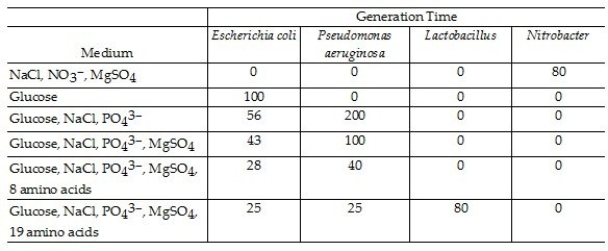
Bacterial generation times for four different bacterial species were calculated in the media listed in Table 6.3. All media were prepared with tap water and incubated aerobically in the light. Compare and contrast the growth requirements of the four bacteria listed above. Which of the media, if any, are chemically defined?

Bacterial generation times for four different bacterial species were calculated in the media listed in Table 6.3. All media were prepared with tap water and incubated aerobically in the light. Compare and contrast the growth requirements of the four bacteria listed above. Which of the media, if any, are chemically defined?

Unlock Deck
Unlock for access to all 57 flashcards in this deck.
Unlock Deck
k this deck
44
Most pathogenic bacteria are thermophiles.

Unlock Deck
Unlock for access to all 57 flashcards in this deck.
Unlock Deck
k this deck
45
Filtration methods are used to count bacteria present in very low concentrations, such as in lakes and streams.

Unlock Deck
Unlock for access to all 57 flashcards in this deck.
Unlock Deck
k this deck
46
Table 6.1
Three different culture media are shown below.
-In Table, 6.1, in which medium (or media) would an autotroph grow?
A) A
B) B
C) C
D) A and B
E) A and C
Three different culture media are shown below.
-In Table, 6.1, in which medium (or media) would an autotroph grow?
A) A
B) B
C) C
D) A and B
E) A and C

Unlock Deck
Unlock for access to all 57 flashcards in this deck.
Unlock Deck
k this deck
47
Agar is used as a solidifying agent in microbiological media since few bacteria can degrade it.

Unlock Deck
Unlock for access to all 57 flashcards in this deck.
Unlock Deck
k this deck
48
Laboratory cultivation of obligate anaerobes requires reducing media or special growth chambers filled with inert gases.

Unlock Deck
Unlock for access to all 57 flashcards in this deck.
Unlock Deck
k this deck
49
Table 6.2
The following data show growth of two bacteria on different media.
-The data in Table 6.2 indicate that S. aureus is a(n)
A) facultative halophile.
B) aerobe.
C) facultative anaerobe.
D) halophile.
E) mesophile.
The following data show growth of two bacteria on different media.
-The data in Table 6.2 indicate that S. aureus is a(n)
A) facultative halophile.
B) aerobe.
C) facultative anaerobe.
D) halophile.
E) mesophile.

Unlock Deck
Unlock for access to all 57 flashcards in this deck.
Unlock Deck
k this deck
50
Turbidity is an indirect measurement of bacterial growth that can be measured using a spectrophotometer.

Unlock Deck
Unlock for access to all 57 flashcards in this deck.
Unlock Deck
k this deck
51
Three cells with generation times of 60 minutes are inoculated into a culture medium. How many cells are there after 5 hours?
A) 900
B) 180
C) 96
D) 32
E) 15
A) 900
B) 180
C) 96
D) 32
E) 15

Unlock Deck
Unlock for access to all 57 flashcards in this deck.
Unlock Deck
k this deck
52
Pure cultures can easily be obtained on streak plates, even if the desired bacteria are present in very low concentrations.

Unlock Deck
Unlock for access to all 57 flashcards in this deck.
Unlock Deck
k this deck
53
The biosafety level (BSL) for a clinical microbiology laboratory working with potentially airborne pathogens, such as tuberculosis bacteria, is
A) BSL- 1.
B) BSL- 2.
C) BSL- 3.
D) BSL- 4.
A) BSL- 1.
B) BSL- 2.
C) BSL- 3.
D) BSL- 4.

Unlock Deck
Unlock for access to all 57 flashcards in this deck.
Unlock Deck
k this deck
54
Figure 6.4


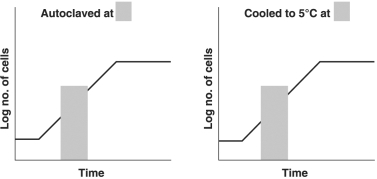
In each graph in Figure 6.4, the culture was incubated at 30°C in glucose- minimal salts broth, aerobically. The bacterium is a facultative anaerobe with an optimum temperature of 37°C and can metabolize glucose and lactose. Indicate how each growth curve would change under the conditions indicated in each graph. Draw the new graphs, or write "no change."



In each graph in Figure 6.4, the culture was incubated at 30°C in glucose- minimal salts broth, aerobically. The bacterium is a facultative anaerobe with an optimum temperature of 37°C and can metabolize glucose and lactose. Indicate how each growth curve would change under the conditions indicated in each graph. Draw the new graphs, or write "no change."

Unlock Deck
Unlock for access to all 57 flashcards in this deck.
Unlock Deck
k this deck
55
Bacterial growth refers to an increase in the numbers of cells in a bacterial culture.

Unlock Deck
Unlock for access to all 57 flashcards in this deck.
Unlock Deck
k this deck
56
An isolated colony on a streak plate contains millions or billions of identical cells.

Unlock Deck
Unlock for access to all 57 flashcards in this deck.
Unlock Deck
k this deck
57
Nitrogen- fixing bacteria, such as cyanobacteria, can use atmospheric nitrogen (N2) for their nitrogen source.

Unlock Deck
Unlock for access to all 57 flashcards in this deck.
Unlock Deck
k this deck



